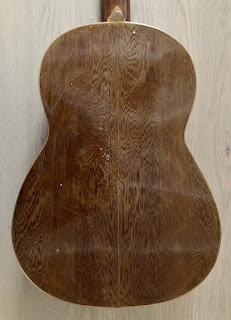Hier toch nog een keer wat nadere informatie over het gitaartje
wat ik onlangs gescoord heb. Of het qua geluid iets is, zal de
toekomst nog uit moeten wijzen. Er moet nu nog te veel in orde
gemaakt worden. De kam is slecht en niet op de juiste plaats
gelijmd. Bovendien met een soort Bisonkit lijkt wel. Ook is de
kam veel te dik gelaten maar dat corrigeer ik toch wel even.
VERKOCHT.
De achterkant die zijn sporen misschien niet verdiend
maar wel gekregen heeft. Maar het is allemaal reparabel.
Wel bijzonder is dat zowel achterkant als zijkanten een
typische wenge "vlam". vertonen terwijl notenhout
destijds toch veel gangbaarder (en goedkoper) was.
Wat scheuren die wel dichtgezet gaan worden. Opvallend
zijn de balkjes die op de zijbladen geplaatst zijn, dus van
boven- naar onderblad lopend en dat op een afstand van plm.
8 cm van elkaar over de hele omtrek gelijmd. Ik heb het in
dat aantal nog nooit in een gitaar aangetroffen. Houdt het
zijblad wel netjes recht natuurlijk maar maakt de gitaar
ook zwaarder en wellicht wat minder resonant.
Bekend van deze Valenciaanse gitaartjes is het "uitge-
kristalliseerde verfwerk dat gelukkig gemakkelijk te
verwijderen is. Het is namelijk veel te gevoelig voor
krassen die er duidelijk zichtbaar en dus lelijk op
naar voren komen. Wel een waaiervormige bracing
bestaande uit 5 balkjes. De schaal van deze gitaar
is 645 mm dus comfortabel te bespelen.
Bepaald geen symmetrische kop maar gezien wat
lichte beschadigingen aan de voorkant van de kop
wordt dat natuurlijk meteen "meegenomen".
De typisch Valenciaanse manier van werken met
een wat zachtere houtsoort die als hak fungeert.
Een label dat ik nog niet ben tegengekomen van deze bouwer.
Uiteindelijk op de site van Ton Bogaard dit label wel gevonden:
Het plaatst de gitaar als komende uit de jaren vijftig!
Bij werkzaamheden in de klankkast verpulverde het originele label
meteen. Gelukkig had ik er al van te voren een foto van gemaakt!
Wel prima werkende geklonken mechanieken welke
dus niet uit de plaat gebogen zijn. RAED Patentado.
Een net wat luxer rozetje en een waaierbebalking
bestaande uit 5 netjes geschaafde balkjes. Uiteraard
verder de koperen frets in een hoogstwaarschijnlijk
notenhouten toets in dit geval.
Een foto van de nu kale achterkant. Het is vrij gemakkelijk
om een oudere Spaanse gitaar van zijn laklaag te ontdoen.
Dat heeft alles te maken met het kristalliseren van de nitro
cellulose lak, een proces wat zich altijd na enkele tientallen
jaren voltrekt. De tekening van het hout wordt alleen maar
beter zichtbaar en de achterkant is klaar om gerepareerd
te worden en nadien netjes uit te vlakken.
Door de kale achterkant met een vochtige doek met
terpentine in te smeren, krijg je een idee van de kleur
die de gitaar na een lakbehandeling zal gaan krijgen.
De aanvankelijk gelige kleur is helemaal weg.
Het wordt allemaal veel roder. Teakhout, wat soms
veel lijkt op wenge, zou een veel geler aanzicht
hebben gegeven. De gitaar verliest deze kleur na
het natmaken pas na een aantal uren. Genoeg tijd
dus om een paar foto's te maken.
De scheuren zijn dichtgezet en het verder spuiten kan
beginnen. Twijfels blijven over de houtsoort aangezien
notenhout soms ook deze structuur kan vertonen....
De randinleg rechtsonder gerepareerd evenals een scheurtje
in de buurt van de toets. Het bovenblad is nog mooi recht en
de balkjes die loszaten zijn weer stevig vastgezet. De kam is
eraf geweest en dunner gemaakt. Bovendien nu toch maar
gekozen voor de juiste plaats i.v.m. de intonatie.
De gitaar ziet er weer netjes uit en is gestabiliseerd voor wat
betreft een scheurtje dat linksboven in het bovenblad zat.
De achterkant was er wat erger aan toe en heeft diverse inzetten
gekregen. Het blijft zichtbaar maar kan weer een leven lang mee.
Nog steeds onduidelijk om wat voor houtsoort het gaat.
Misschien toch geen Wenge?
Ik kan het niet laten om zo'n kop dan toch weer
enigszins symmetrisch te krijgen en wat kopbe-
schadigingen weg te halen aan de achterkant.
Leuk klinkende gitaar maar steekt niet met kop
en schouders uit boven zijn "soortgenoten".



























